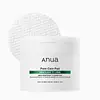What's inside
What's inside
 Key Ingredients
Key Ingredients

 Benefits
Benefits

 Ingredients Side-by-side
Ingredients Side-by-side

Water
Skin ConditioningGlycerin
HumectantDipropylene Glycol
HumectantNiacinamide
SmoothingMethylpropanediol
Solvent1,2-Hexanediol
Skin ConditioningHydroxyacetophenone
AntioxidantPanthenol
Skin ConditioningSorbitol
HumectantBetaine
HumectantAllantoin
Skin ConditioningCaffeine
Skin Conditioning3-O-Ethyl Ascorbic Acid
Skin ConditioningPropanediol
SolventEthylhexylglycerin
Skin ConditioningAdenosine
Skin ConditioningAcrylates/C10-30 Alkyl Acrylate Crosspolymer
Emulsion StabilisingPolyglyceryl-10 Isostearate
Skin ConditioningSodium Phytate
Tromethamine
BufferingXanthan Gum
EmulsifyingPolyglyceryl-10 Oleate
Skin ConditioningButylene Glycol
HumectantArginine
MaskingCynanchum Atratum Extract
Skin ConditioningCaprylic/Capric Triglyceride
MaskingAlthaea Rosea Flower Extract
Skin ConditioningHouttuynia Cordata Extract
Skin ConditioningHydrogenated Lecithin
EmulsifyingPentylene Glycol
Skin ConditioningSimmondsia Chinensis Seed Oil
EmollientPolyglyceryl-4 Caprate
EmulsifyingPolyglyceryl-6 Caprylate
EmulsifyingBeta-Sitosterol
Emulsion StabilisingPolyglyceryl-10 Stearate
Skin ConditioningCholesterol
EmollientChitosan
Ascorbic Acid
AntioxidantAscorbyl Glucoside
AntioxidantCeramide NP
Skin ConditioningWater, Glycerin, Dipropylene Glycol, Niacinamide, Methylpropanediol, 1,2-Hexanediol, Hydroxyacetophenone, Panthenol, Sorbitol, Betaine, Allantoin, Caffeine, 3-O-Ethyl Ascorbic Acid, Propanediol, Ethylhexylglycerin, Adenosine, Acrylates/C10-30 Alkyl Acrylate Crosspolymer, Polyglyceryl-10 Isostearate, Sodium Phytate, Tromethamine, Xanthan Gum, Polyglyceryl-10 Oleate, Butylene Glycol, Arginine, Cynanchum Atratum Extract, Caprylic/Capric Triglyceride, Althaea Rosea Flower Extract, Houttuynia Cordata Extract, Hydrogenated Lecithin, Pentylene Glycol, Simmondsia Chinensis Seed Oil, Polyglyceryl-4 Caprate, Polyglyceryl-6 Caprylate, Beta-Sitosterol, Polyglyceryl-10 Stearate, Cholesterol, Chitosan, Ascorbic Acid, Ascorbyl Glucoside, Ceramide NP
Houttuynia Cordata Extract 77%
Skin ConditioningWater
Skin ConditioningGluconolactone
Skin ConditioningPropanediol
SolventTromethamine
BufferingButylene Glycol
Humectant1,2-Hexanediol
Skin ConditioningBetaine
HumectantAmmonium Acryloyldimethyltaurate/Vp Copolymer
Ulmus Davidiana Root Extract
Skin ConditioningPueraria Lobata Root Extract
HumectantPinus Palustris Leaf Extract
TonicOenothera Biennis Flower Extract
AstringentCamellia Sinensis Leaf Extract
AntimicrobialCoix Lacryma-Jobi Ma-Yuen Seed Extract
Skin ConditioningPortulaca Oleracea Extract
Skin ConditioningCentella Asiatica Extract
CleansingMadecassoside
AntioxidantAsiatic Acid
Skin ConditioningAsiaticoside
AntioxidantMadecassic Acid
Skin ConditioningSodium Phytate
Houttuynia Cordata Extract 77%, Water, Gluconolactone, Propanediol, Tromethamine, Butylene Glycol, 1,2-Hexanediol, Betaine, Ammonium Acryloyldimethyltaurate/Vp Copolymer, Ulmus Davidiana Root Extract, Pueraria Lobata Root Extract, Pinus Palustris Leaf Extract, Oenothera Biennis Flower Extract, Camellia Sinensis Leaf Extract, Coix Lacryma-Jobi Ma-Yuen Seed Extract, Portulaca Oleracea Extract, Centella Asiatica Extract, Madecassoside, Asiatic Acid, Asiaticoside, Madecassic Acid, Sodium Phytate
 Reviews
Reviews

Ingredients Explained
These ingredients are found in both products.
Ingredients higher up in an ingredient list are typically present in a larger amount.
1,2-Hexanediol is a synthetic liquid and another multi-functional powerhouse.
It is a:
- Humectant, drawing moisture into the skin
- Emollient, helping to soften skin
- Solvent, dispersing and stabilizing formulas
- Preservative booster, enhancing the antimicrobial activity of other preservatives
Betaine is a common humectant (a substance that promotes retention of moisture). It's known to be gentle on the skin and can help balance hydration.
This ingredient is best for improving hydration and soothing irritated skin. Studies also show it helps even out skin tone.
Fun fact: Betaine is naturally created in the skin and body. The kind found within cosmetic products can be either plant-derived or synthetic.
Another name for betaine is trimethylglycine.
Learn more about BetaineButylene Glycol (or BG) is used within cosmetic products for a few different reasons:
Overall, Butylene Glycol is a safe and well-rounded ingredient that works well with other ingredients.
Though this ingredient works well with most skin types, some people with sensitive skin may experience a reaction such as allergic rashes, closed comedones, or itchiness.
Learn more about Butylene GlycolHouttuynia Cordata Extract is more commonly known as Heart Leaf, Fish Mint, or Chameleon plant.
The components found in Heart Leaf give it antioxidant, hydrating, antimicrobial, and anti-inflammatory properties.
Heart Leaf is rich in flavonoids such as quercetin, apigenin, and more. It also contains polysaccharides, the most common type of carbs in food.
Flavonoids have been shown to be effective antioxidants. They help neutralize free-radical molecules. Free-radical molecules are unstable molecules that may damage our skin cells and DNA. The flavonoids in Heart Leaf also help soothe the skin.
Polysaccharides are naturally found in our skin. They play a role in hydrating and repairing the top layer of skin. The polysaccharides in Heart Leaf help moisturize our skin.
Studies show decanoyl acetaldehyde, a component of Heart Leaf oil, is effective at killing bacteria.
The name 'Fish Mint' comes from the herb's natural fishy smell. Is is native to southeast Asia and used throughout the continent for traditional cooking and medicine.
Learn more about Houttuynia Cordata ExtractPropanediol is an all-star ingredient. It softens, hydrates, and smooths the skin.
It’s often used to:
Propanediol is not likely to cause sensitivity and considered safe to use. It is derived from corn or petroleum with a clear color and no scent.
Learn more about PropanediolSodium Phytate is the synthetic salt form of phytic acid. Phytic acid is an antioxidant and can be found in plant seeds.
Sodium Phytate is a chelating agent. Chelating agents help prevent metals from binding to water. This helps stabilize the ingredients and the product.
Tromethamine helps balance the pH and improve the texture of a product. It is synthetically created.
As an emulsifier, Tromethamine prevents oil and water ingredients from separating. This helps stabilize the product and elongate a product's shelf life. Tromethamine also makes a product thicker.
Tromethamine helps balance the pH level of a product. Normal pH level of skin is slightly acidic (~4.75-5.5). The acidity of our skin is maintained by our glands and skin biome. Being slightly acidic allows our skin to create an "acid mantle". This acid mantle is a thin barrier that protects our skin from bacteria and contaminants.
Oral Tromethanmine is an anti-inflammatory drug but plays the role of masking, adding fragrance, and/or balancing pH in skincare.
1,3-Propanediol, 2-amino-2-(hydroxymethyl)-
Learn more about TromethamineWater. It's the most common cosmetic ingredient of all. You'll usually see it at the top of ingredient lists, meaning that it makes up the largest part of the product.
So why is it so popular? Water most often acts as a solvent - this means that it helps dissolve other ingredients into the formulation.
You'll also recognize water as that liquid we all need to stay alive. If you see this, drink a glass of water. Stay hydrated!
Learn more about Water